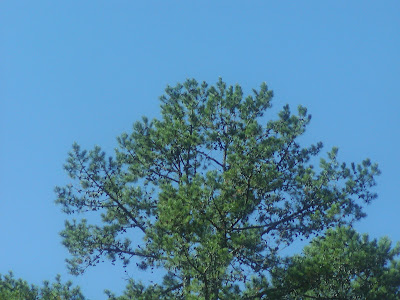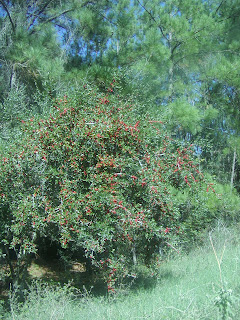 |
| Native Yaupon Holly, Species: Ilex vomitoria, See UT Austin Native Plant Database |
Ah well . . . too much negativity. After all, Pakistan is pondering . . . some sort of action; the Chinese own the USA (or some say it's so) . . . Iran has a bomb, no doubt . . . and Israel ain't exactly a coward . . . and mighty Egypt really has some twisted issues that will effect the rest of the world when they all settle out . . . and let me not forget the more than 50% of the USA that is on the government dole one way or the other . . . or so it seems. Put the current eye-rolling Republican race for the presidential nomination in the mix and what do you have? More negativity. . . I might as well forget about it all and just eat my soup -- I'll go with the Clam Chowder, heavily seasoned with black pepper, along with a side of hot American cheese toast on Jewish rye -- my absolute favorite.
 |
| Native Pine Tree, See UT Austin's Texas Beyond History The Pine Forests of East Texas |
And I'll take a walk outside and see what beautiful wonders God has brought to these Pineywoods that seem forever green -- even in the dark dry days of our summer drought the mighty pines stood tall and green. Yes, some have suffered, there are some orange tops in the horizon of green pine tops - but not so many, pine trees appear to be good troopers, positive thinkers.
Intermixed with those glorious, reaching to the sky green pine trees in the fall of the year in eastern Texas, at least for sure this pocket of the more southeasterly section -- are native yaupons. Some of the yaupons are males, some females. The female yaupon puts off the most beautiful red berries; they are like a gift, a vision of something that bespeaks of newness and hope and warmth, despite the fact they come with the onset of cold. Those bright red berries and deep green leaves are nature's Christmas show in these Pineywoods.
Over the past decade I have been quite 'eccentric', some would say, about any inadvertent killing of my female yaupon. If a fence must be cleared, leave the female yaupon; if a gate must be put in a section of fence, move it away from the female yaupon; if the female yaupon is growing beneath a tree grove -- leave it be! I am watching, and I'll know if you chop her down.
This past week I took some photos of female yaupons in full fruit, along with some shots of the pine trees reaching for the blue sky. It seemed appropriate. We have been blessed with some terribly needed rains the past few weeks. One of them jumped the big pond by probably 8 feet over night. All of the hardwood trees were sore in need of those rains to keep them alive until the spring, and no doubt the sturdy pine trees needed it as well to keep on being the green blessing that they always are on my horizon. While the yaupon are notoriously tolerant to dry conditions, they surely are dancing when I'm not looking for the gift of the fall rains that will support the growth of new youngsters, male and female yaupon alike, with the coming of the next spring.




